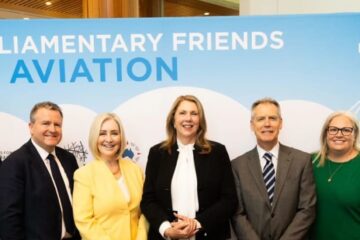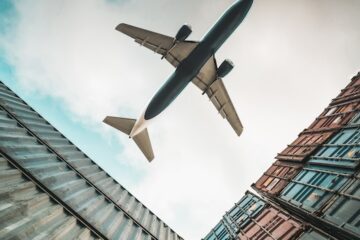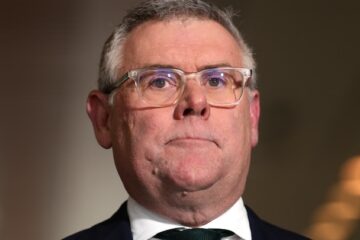Media Release 22 Dec 2023
- A new research report estimates upwards of 242,000 greater Brisbane residents are severely impacted by aircraft noise pollution from Brisbane Airport.
- Health and social costs are estimated at $9,000 per person per year based on a methodology from recent research on Brussels airport in Belgium.
- By 2032, Brisbane Airport’s excessive aircraft noise problem will drain $18.9 billion from Queensland’s health budget.
- Cardiovascular disease, negative impacts on children’s learning, mental health disorders such as depression and anxiety, and productivity loss due to sleep disturbance caused by aircraft noise exposure are backed by strong scientific evidence, which the report cites.
- Airservices Australia now offer free mental health counselling services to Brisbane residents.
A new report by environmental scientist Dr Sean Foley has found a $2.1 billion health and social cost year on year to Queensland from aircraft noise from Brisbane Airport unless a curfew and flight cap are introduced. The findings estimate approximately 242,000 greater Brisbane residents are severely impacted by aircraft noise associated with Brisbane’s airspace architecture and airport operations.
The cost findings are based on a methodology used by French aviation consultancy, ENVISA, who undertook similar research earlier this year on the health and social impacts of Brussels Airport’s noise pollution. Dr Foley’s research contextualised the methodology to South East Queensland, conservatively adjusting the cost projections down to account for differences in cost of living and incomes between Belgium and Australia.
Decades-long peer-reviewed scientific research on noise pollution has concluded that it worsens health outcomes for those chronically exposed, even if they are not consciously bothered by the noise. A 15-year Swiss study found there is a strong, measurable link between aircraft noise exposure and heart attack deaths, strokes and high blood pressure. The negative effects start as low as 40 decibels and worsen the louder and more frequent the noise exposure.
In the 2020 BFPCA community survey 68% of people reported mental distress from aircraft noise – this figure has jumped to over 74% in the latest survey as a result of the increased traffic at Brisbane Airport. Due to the severe mental distress experienced by Brisbane communities, Airservices Australia now offer free mental health counselling services available “to any community member who is feeling negatively affected by aircraft operations.” Airservices have also admitted in Senate Estimates that they have started to send the Queensland Police into people’s homes to conduct welfare checks as a result of the harm caused by the flight path noise pollution.
The World Health Organisation’s 2022 recommendation for the maximum aircraft noise level exposure is 45 decibels during the day and 40 decibels at night. Suburbs in Brisbane regularly experience flights generating 70-85 decibels of aircraft noise. Some of the worst affected suburbs include Bulimba, Hamilton, New Farm and Tingalpa where there are between 89 and 100 flights per day with most exceeding 70 decibels and some exceeding even 90 decibels according to Airservices Australia’s own noise monitors.
The problem is not confined to these suburbs, however, as Airservices Australia confirmed in Senate Estimates that residents of 226 suburbs across the greater Brisbane area (stretching well outside the Brisbane Local Government Area) have complained about aircraft noise. Suburbs as far away as Upper Brookfield, Samford Valley, and Redland Bay experience flights in excess of 60 decibels.
Children are at particular risk of negative impacts as noise pollution disturbance has been shown to disrupt learning outcomes. Reading scores fall below average when children are exposed to 55 decibels of aircraft noise, one meta-analysis of three studies found. A further German study found “impaired psychological health” in children who were exposed to aircraft noise from a relocated airport in Munich. The same ill effects were noted in the children’s populations at the former airport location that resolved after the airport moved to impact a different community.
These negative effects from Brisbane Airport’s excessive flight noise are what will cause a $2.1 billion drain on Queensland’s health budget per year, equating to $18.9 billion to 2032. This is in contrast with Brisbane Airport Corporation’s estimates that a proposed night-time curfew would negatively impact Queensland’s economy, shrinking it by an estimated $2.8 billion by 2032, which represents just 0.08% of the state’s $360 billion economy.
Brisbane Flight Path Community Alliance (BFPCA) has been calling for a curfew and flight cap to bring Brisbane on par with Sydney Airport whose community won similar protections in the 1990s. More information about BFPCA’s call for curfew and flight caps, as well as the full report are available at bfpca.org.au.
Quotes attributable to Prof. Marcus Foth, BFPCA Chair
“This new research study underlines the scale of the problem greater Brisbane residents exposed to excessive aircraft noise are facing – it’s not just a bit of annoyance, it’s a serious and life-threatening noise pollution problem that in excess of 242,000 community members have to deal with on a daily basis.”
“This research shows that our kids in schools under flight paths like Bulimba, Balmoral, Hawthorne, Hamilton, Hendra, Ascot, New Farm are now suffering negative learning outcomes and poor psychological health as a result of chronic aircraft noise exposure – not to mention how the problem also follows them home.”
“Putting this in dollar-figures, these health impacts will cost the Queensland Government’s health budget bottom-line $18.9 billion to 2032. It’s time we ask ourselves how many doctors, nurses, hospitals, teachers and other vital infrastructure upgrades are Queenslanders willing to forgo so Brisbane Airport Corporation can walk away with their sky high profits?”
“Brisbane Airport Corporation says the proposed curfew and flight cap would cost the Queensland economy $2.8 billion to 2032 – you can guarantee they will not pick up the bill for the remaining $16.1 billion of health and social damage their operations will cause.”
“Greater Brisbane residents impacted by aircraft noise are not unreasonable and do not want to stop Brisbane Airport operations – they simply want what their neighbours in Sydney have; a curfew and a flight cap. Even with these restrictions, Sydney Airport manages to be Australia’s busiest and most profitable – it’s time Brisbane Airport respects its host city and stops privatising the profits while socialising the losses.”
ENDS
Media contact: Professor Marcus Foth, BFPCA Chair, contact@bfpca.org.au
About BFPCA
With the launch of Brisbane Airport’s New Parallel Runway on 12 July 2020 came a new airspace design and flight paths that concentrate aircraft noise over densely populated residential areas.
Brisbane Airport and Airservices Australia sold this project to Brisbane communities suggesting the New Parallel Runway will enable them to prioritise “over water” operations that direct planes away from residential areas. The CEO Gert-Jan de Graaff is on the record saying, “the net effect of aircraft flying over the city will decrease.”
Brisbane families and communities are suffering from excessive noise pollution and associated health and related impacts from Brisbane Airport’s new flight paths launched in July 2020. The Aircraft Noise Ombudsman report, the Brisbane Airport PIR Advisory Forum (BAPAF) and flight path design consultants TRAX International have all confirmed that Brisbane communities were misled using flawed noise modelling, deceiving community engagement, and offered inadequate noise abatements.
Brisbane Flight Path Community Alliance (BFPCA) came together in 2020 to fight back on behalf of all Brisbane families and communities experiencing this noise pollution.
For more background information, visit: https://bfpca.org.au/
About the Report’s Author
Dr Sean Foley BSc (Hons) PhD FRGS is an esteemed Australian environmental scientist. His academic journey commenced with a Bachelor of Science with Honours from Murdoch University in Western Australia, followed by the successful completion of a PhD in Human Ecology at the Australian National University (ANU). Recognised for his exceptional contributions to geography and environmental science, Dr Foley was inducted as a Fellow of the Royal Geographical Society (FRGS). His work is widely acknowledged in the academic community, with more than 2,000 citations and an h-index of 18. His extensive research portfolio includes numerous peer-reviewed publications in renowned scientific journals, reflecting his commitment to scientific communication and public outreach. Dr Foley’s interdisciplinary expertise spans natural resource and environmental management, environmental legislation, public health economics, international aid and development, policy analysis, and project design and management. He has also served as a consultant for the World Bank, contributing his expertise to global environmental and developmental initiatives. Dr. Foley’s leadership extends beyond academia; he has been an Executive Board Member of the Australia and New Zealand Society for Ecological Economics since 2014 and a Fellow and Board Chair of the Samdhana Institute since 2006.
Peer-reviewed scientific research studies
Basner, M., Clark, C., Hansell, A., Hileman, J. I., Janssen, S., Shepherd, K., & Sparrow, V. (2017). Aviation Noise Impacts: State of the Science. Noise & Health, 19(87), 41–50. https://doi.org/10.4103/nah.NAH_104_16
Clark, C., Head, J., Haines, M., van Kamp, I., van Kempen, E., & Stansfeld, S. A. (2021). A meta-analysis of the association of aircraft noise at school on children’s reading comprehension and psychological health for use in health impact assessment. Journal of Environmental Psychology, 76, 101646. https://doi.org/10.1016/j.jenvp.2021.101646
Frenis, K., et al. (2021). Long-Term Effects of Aircraft Noise Exposure on Vascular Oxidative Stress, Endothelial Function and Blood Pressure: No Evidence for Adaptation or Tolerance Development. Frontiers in Molecular Biosciences, 8, 814921. https://doi.org/10.3389/fmolb.2021.814921
Hahad, O., Bayo Jimenez, M. T., Kuntic, M., Frenis, K., Steven, S., Daiber, A., & Münzel, T. (2022). Cerebral consequences of environmental noise exposure. Environment International, 165, 107306. https://doi.org/10.1016/j.envint.2022.107306
Mackensen, S. V., Bullinger, M., Meis, M., Evans, G. W., & Hygge, S. (1999). The psychological cost of aircraft noise for children. The Journal of the Acoustical Society of America, 105 (2_Supplement), 1219–1219. https://doi.org/10.1121/1.425878
Münzel, T., Treede, H., Hahad, O., & Daiber, A. (2023). Too Loud to Handle? Transportation Noise and Cardiovascular Disease. The Canadian Journal of Cardiology, 39(9), 1204–1218. https://doi.org/10.1016/j.cjca.2023.02.018
Vienneau, D., Saucy, A., Schäffer, B., Flückiger, B., Tangermann, L., Stafoggia, M., Wunderli, J. M., Röösli, M., & SNC study group. (2022). Transportation noise exposure and cardiovascular mortality: 15-years of follow-up in a nationwide prospective cohort in Switzerland. Environment International, 158, 106974. https://doi.org/10.1016/j.envint.2021.106974
This is just a selection of papers. There is a well-established body of peer-reviewed scientific literature on the severe negative impacts of aircraft noise pollution and aircraft exhaust emissions on human health and wellbeing as well as learning and cognitive abilities of children in the proximity of airports. BFPCA has started to gather a list of peer-reviewed academic papers on these topics, which can be found in the BFPCA Library.


